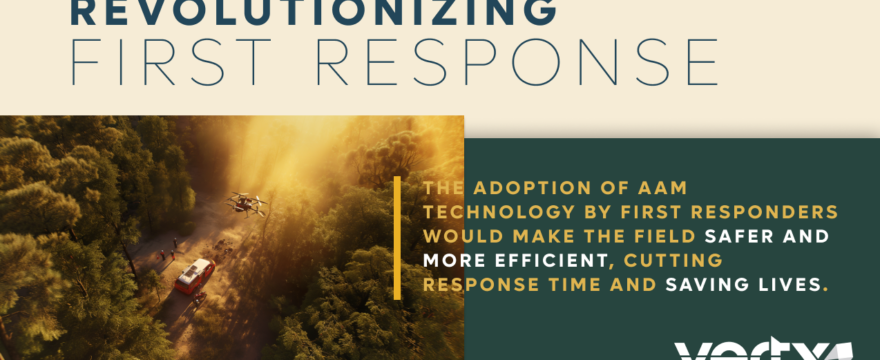Vertx Partners is bringing Advanced Air Mobility to rural areas like West Virginia – here is how it’ll affect first responders in the Mountain State.

Building off our earlier article detailing how Advanced Air Mobility (AAM) will affect West Virginia’s healthcare system, we’ll examine a different yet related topic: how AAM impacts first responders.
In the evolving emergency response field, AAM has already redefined the capabilities of first responders in West Virginia and beyond. Recent success stories provide a glimpse into the immense potential of AAM for first responders. If you’re curious to read more about potential AAM applications and how programs like ASSUREd Safe are working in West Virginia to bring this technology into the hands of first responders, check out this recent Deloitte study. This article explores how AAM technologies can revolutionize the roles of law enforcement officers (LEOs), emergency medical services (EMS) workers, and firefighters in the Mountain State.
A Glimpse into AAM’s Potential for Law Enforcement
Readers may be familiar with this January 2024 story. Here, Robbinsville, NJ, police department showcased the power of drones in locating a missing child in less than 10 minutes. In West Virginia, rugged terrain and remote locations pose significant challenges. Because of this, drones equipped with advanced surveillance capabilities could become invaluable tools for LEOs. From locating missing persons to monitoring large events, AAM provides a unique aerial perspective that enhances situational awareness and expedites response times.
AAM in Emergency Medical Services
Building on the concepts outlined in our earlier discussion on rural healthcare, AAM in EMS can be a game-changer. Drones equipped with medical supplies can swiftly reach remote areas, delivering critical treatment before EMS personnel are even on-site. The ability to assess a situation from the air allows for better-informed decisions and more efficient allocation of resources.
We encourage you to read our earlier article linked above for a more in-depth discussion.
Natural Disasters and AAM: Aerial Reconnaissance and Community Assessment
The West Virginia Division of Forestry (WVDOF) has already embraced drone technology. For example, tasks like inspecting logging operations and performing wildfire reconnaissance are easy using drones. Here’s yet another example of AAM reducing the time required for these tasks while minimizing risks to human life. In the context of natural disaster response, drone pilots also deploy drones to scout out flood damage and evaluate rural communities hit hard by other natural disasters.
Developing a Skilled AAM Workforce
AAM curricula lay the groundwork for training the next generation of first responders. Marshall University plans to roll out its curriculum in the Fall of 2024. Meanwhile, Blue Ridge Community & Technical College and Southern West Virginia Community & Technical College plan to offer UAS certifications as well. The former will offer an Associate of Applied Science degree and a Certificate of Applied Science through their program, including coaching students for their Part 107 exam which certifies commercial operation.
As these programs become widespread and standardized, West Virginia can cultivate a skilled workforce equipped to harness the full potential of AAM technologies. Integrating AAM education into first responder training will ensure that professionals are adept at utilizing these cutting-edge tools in the field.
Additionally, integrating AAM into first responder fields will create new opportunities for those wishing to serve their communities and save lives.
Looking Ahead: The AAM First Responder Revolution
In November 2023, a tentative agreement between manufacturer Jump Aero and Oregon’s Department of Aviation hinted at the next phase in the AAM first responder revolution. The JA1 Pulse eVTOL is designed to complement existing first responder methods. Additionally, the JA1 demonstrates the ongoing innovation in the AAM space. It could hint at what’s in store for communities and regions that invest in this technology early on.
As West Virginia continues to explore and adopt AAM technologies, it positions itself at the forefront of this revolution, paving the way for safer, more efficient, and more effective emergency response strategies. The skies over West Virginia aren’t just pathways – they’re the frontier of a new era in first responder operations.
Contact us today to stay current with the latest news and become involved in Vertx Partners’ AAM efforts.





